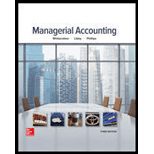
Concept explainers
Concept introduction:
Managerial Decision:
Decision making plays an important role in the management. The decisions taken by managers are called managerial decisions. Managerial Decisions are decisions taken by managers for the operations of a firm. These decisions include setting target growth rates, hiring or firing employees, and deciding what products to sell. Manager’s decisions are taken on the basis of quantitative as well as the qualitative measures. The managerial decision includes the decisions like make or buy, accept or reject new offers, sell or further process etc. These decisions are taken on the basis of relevant costs.
Relevant costs are the costs that are relevant for any decision making. Relevant costs are helpful for take managerial decisions like make or buy, accept or reject new offers, sell or further process etc.
Two basic types of the relevant costs are as follows:
- Out-of-pocket costs
- Opportunity costs
To indicate:
The two relevant and two irrelevant costs for the trip decision
Want to see the full answer?
Check out a sample textbook solution
Chapter 1 Solutions
Managerial Accounting
- Don't use ai given answer accounting questionsarrow_forwardMultiple Choice 2-32 Educational Incentives (LO 2.14) Wendy is a single taxpayer and pays tuition of $7,800 in 2021. Her 2021 AGI is $66,000. What is the amount of Wendy's tuition deduction? X a. $2,000 O b. $0 O c. $3,733.33 O d. $4,000 O e. $7,800arrow_forwardMultiple Choice 2-32 Educational Incentives (LO 2.14) Wendy is a single taxpayer and pays tuition of $7,800 in 2021. Her 2021 AGI is $66,000. What is the amount of Wendy's tuition deduction? X a. $2,000 O b. $0 O c. $3,733.33 O d. $4,000 O e. $7,800arrow_forward
- Principles of Accounting Volume 2AccountingISBN:9781947172609Author:OpenStaxPublisher:OpenStax College
 Essentials of Business Analytics (MindTap Course ...StatisticsISBN:9781305627734Author:Jeffrey D. Camm, James J. Cochran, Michael J. Fry, Jeffrey W. Ohlmann, David R. AndersonPublisher:Cengage Learning
Essentials of Business Analytics (MindTap Course ...StatisticsISBN:9781305627734Author:Jeffrey D. Camm, James J. Cochran, Michael J. Fry, Jeffrey W. Ohlmann, David R. AndersonPublisher:Cengage Learning



